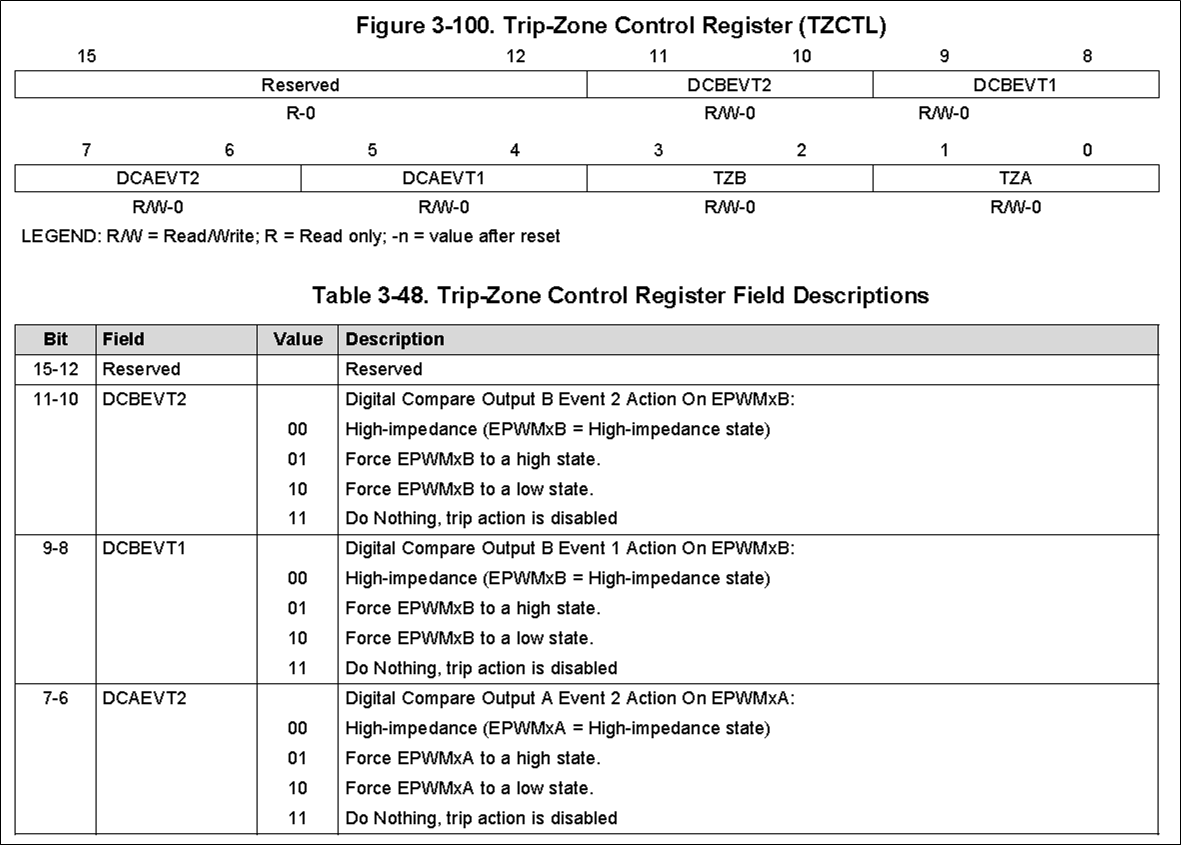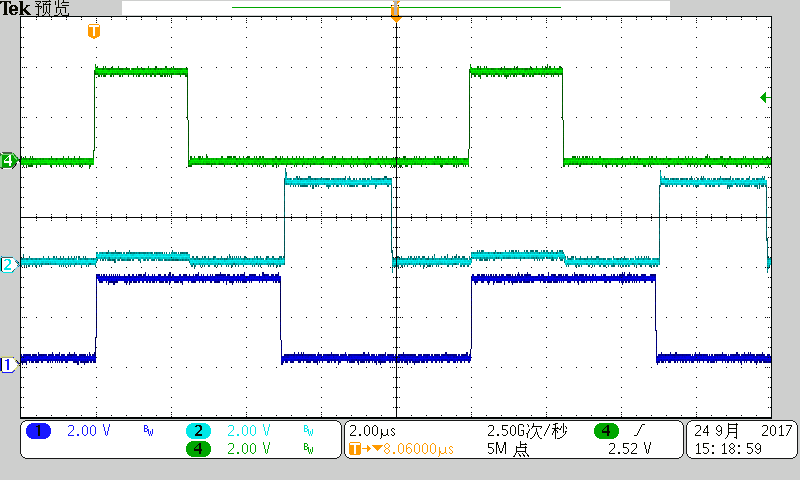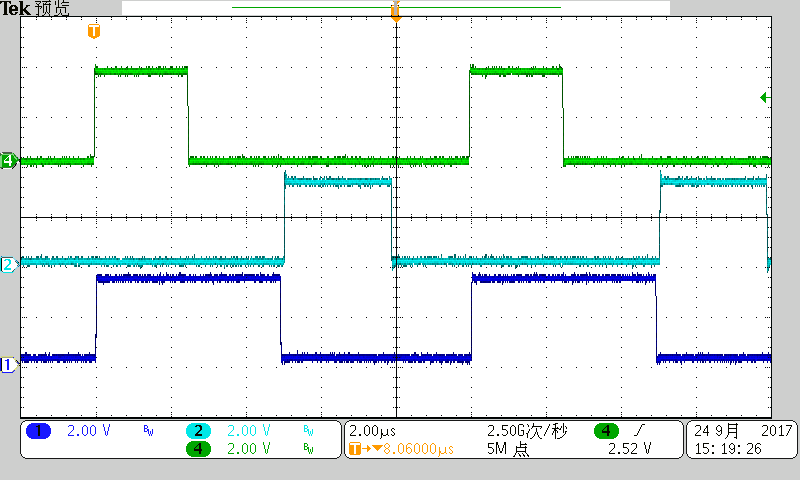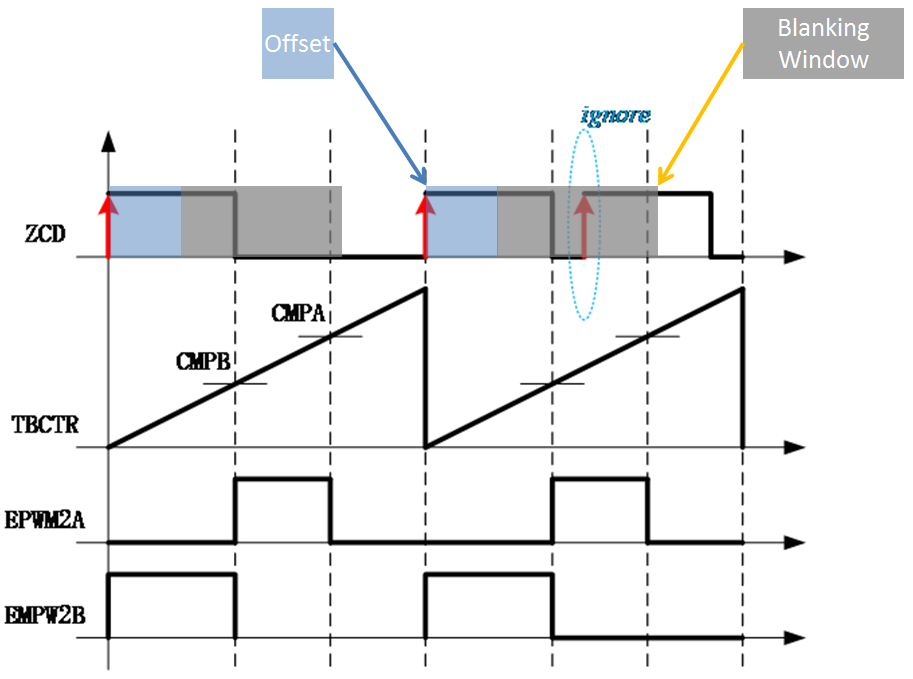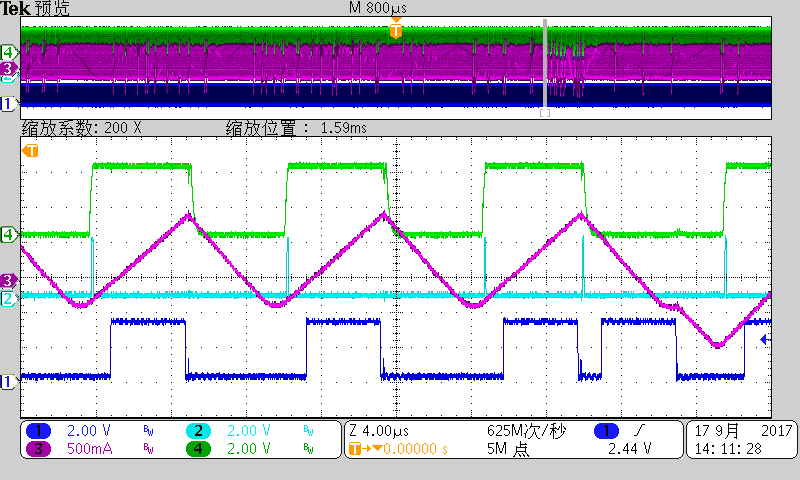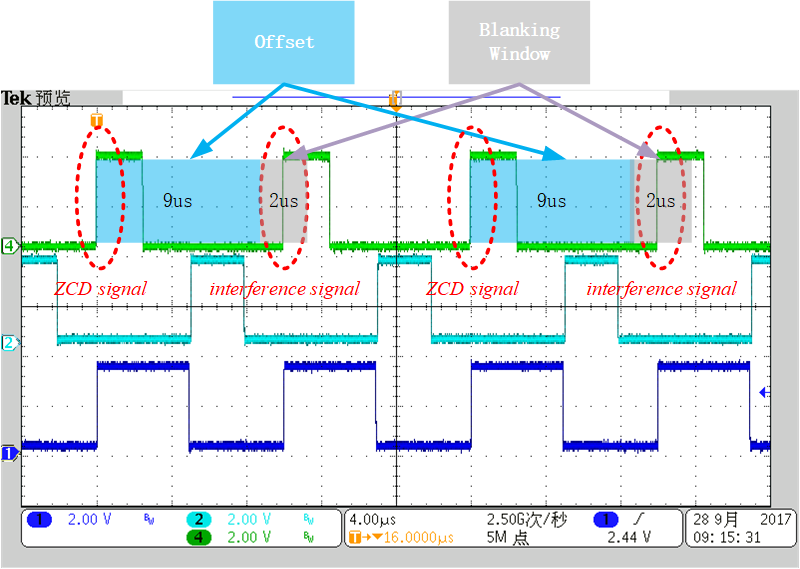Tool/software: Code Composer Studio
There is a ZCD signal input DSP, and then DSP output EPWM2A and EPWM2B, and their relationship is shown in Fig.1.
Fig.1
The ZCD connects to the TZ2(GPIO13) pin of DSP,when the rise edge of ZCD is coming,the Digital Compare (DC) Submodule of EPWM2 output the DCAEVT1.sync,as the Figure 3-47 shows. If the time between two rise edge is too small, it can use the Blanking Window to filter the second rise edge of ZCD.
As the Figure 3-5 shows, DCAEVT1.sync can load the TBPHS to TBCTR, then the TBCTR increase from zero. When the TBCTR is cleared, the EPWM2B is set. When the TBCTR equal to CMPB, the EPWM2B is cleared and the EPWM2A is set. When the TBCTR equal to CMPA, the EPWM2A is clear.
The experiment result:
CH4(green) is ZCD, CH2(light blue) is EPWM2A, CH1(dark blue) is EPWM2B
There are two questions:
- Why the EPWM2A is not 0V in red dashed box and the time is the same as the high level time of ZCD?
- The second rise edge of ZCD is 10us after the first rise edge. In code, the Blanking Window can filter the second rise edge of ZCD, but in experiment it failed, why?
There is the code and the hardware is LAUNCHXL-F28069M:
#include "math.h"
#include "DSP28x_Project.h"
void InitEPwm2Example(void);
int main(void) {
InitSysCtrl(); // Initialize System Control
InitGpio(); //Initialize GPIO
InitEPwm2Gpio();
InitTzGpio();
//Configure ePWM module
EALLOW;
SysCtrlRegs.PCLKCR0.bit.TBCLKSYNC = 0;
InitEPwm2Example();
SysCtrlRegs.PCLKCR0.bit.TBCLKSYNC = 1;
EDIS;
//wait for timer0 interrupt
for(;;);
}
void InitEPwm2Example(){
// Setup TBCLK
EPwm2Regs.TBCTL.bit.CTRMODE = 0x0; // Count up mode
EPwm2Regs.TBPRD =4500; // Set timer period, for this example set at max value
EPwm2Regs.TBCTL.bit.PHSEN = 0x1; // Enable phase loading
EPwm2Regs.TBPHS.half.TBPHS = 0; // Phase is 0
EPwm2Regs.TBCTR = 0x0000; // Clear counter
EPwm2Regs.TBCTL.bit.HSPCLKDIV = TB_DIV1; // Clock ratio to SYSCLKOUT
EPwm2Regs.TBCTL.bit.CLKDIV = TB_DIV1;
// Setup shadow register load on ZERO
EPwm2Regs.CMPCTL.bit.SHDWAMODE = CC_SHADOW; // Load registers every ZERO
EPwm2Regs.CMPCTL.bit.SHDWBMODE = CC_SHADOW;
EPwm2Regs.CMPCTL.bit.LOADAMODE = CC_CTR_ZERO;
EPwm2Regs.CMPCTL.bit.LOADBMODE = CC_CTR_ZERO;
// Set Compare values
EPwm2Regs.CMPA.half.CMPA = 720; // Set compare A value 8us
EPwm2Regs.CMPB = 450; // Set compare B value 5us
// Set actions
EPwm2Regs.AQCTLA.bit.CBU = AQ_SET; // force EPWM1A output high; the high switch turn on
EPwm2Regs.AQCTLA.bit.CAU = AQ_CLEAR; // force EPWM1A output low; the high switch turn off
EPwm2Regs.AQCTLB.bit.ZRO = AQ_SET; // force EPWM1B output high; the low switch turn on
EPwm2Regs.AQCTLB.bit.CBU = AQ_CLEAR; // force EPWM1B output low; the low switch turn off
//dead time
EPwm2Regs.DBCTL.bit.IN_MODE = 0; // Clear PWM1B on event B, up count
EPwm2Regs.DBCTL.bit.HALFCYCLE = 0; // Clear PWM1B on event B, up count
EPwm2Regs.DBCTL.bit.POLSEL = 0; // Clear PWM1B on event B, up count
EPwm2Regs.DBCTL.bit.OUT_MODE = 2; // Clear PWM1B on event B, up count
EPwm2Regs.DBRED = 9; // Clear PWM1B on event B, up count 0.1us
//DC
EPwm2Regs.DCTRIPSEL.bit.DCAHCOMPSEL = 1; //TZ2 input
EPwm2Regs.TZDCSEL.bit.DCAEVT1 = 2; //DCAH = high, DCAL = don't care
EPwm2Regs.DCACTL.bit.EVT1SYNCE = 1; //SYNC Generation Enabled
EPwm2Regs.DCACTL.bit.EVT1SRCSEL = 0; //0:Source Is DCAEVT1 Signal; 1:Source is DCEVTFILT Signal
//Filter
EPwm2Regs.DCFCTL.bit.PULSESEL = 1; //Time-base counter equal to zero
EPwm2Regs.DCFCTL.bit.BLANKINV = 1; //Blanking window inverted
EPwm2Regs.DCFCTL.bit.BLANKE = 1; //Blanking window is enabled
EPwm2Regs.DCFCTL.bit.SRCSEL = 0; //Source is DCAEVT1 Signal
EPwm2Regs.DCFOFFSET = 810; //Blanking Window Offset 9us
EPwm2Regs.DCFWINDOW = 180; //Blanking Window Width 2us
}







